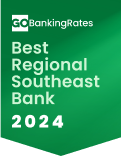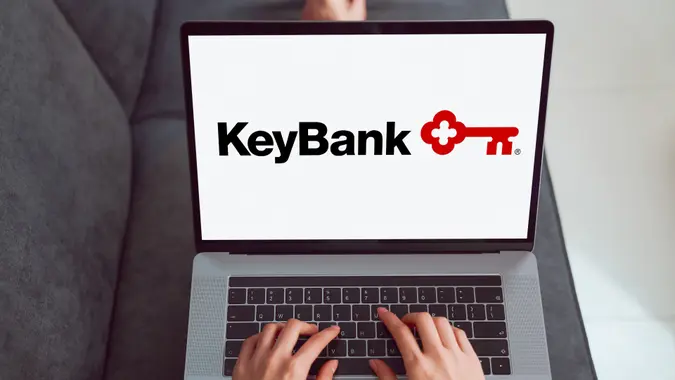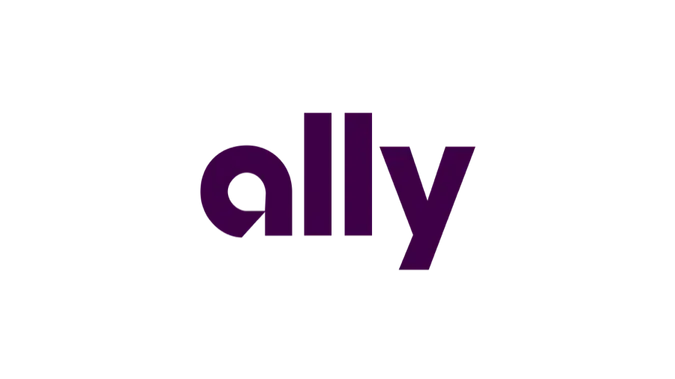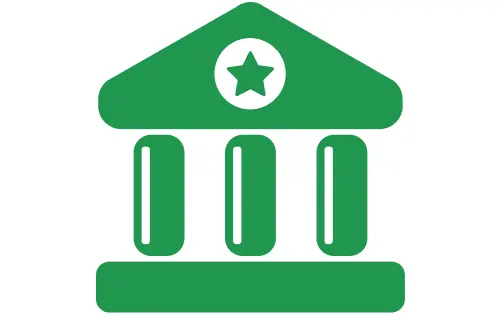Arvest Bank Review: Committed to the Community
Commitment to Our Readers
GOBankingRates' editorial team is committed to bringing you unbiased reviews and information. We use data-driven methodologies to evaluate financial products and services - our reviews and ratings are not influenced by advertisers. You can read more about our editorial guidelines and our products and services review methodology.

20 Years
Helping You Live Richer

Reviewed
by Experts

Trusted by
Millions of Readers
GOBankingRates Score
-
Personal Banking
5.0
-
Business Banking
4.9
-
Loans and Credit Cards
4.8
-
Banking Experience
4.9
Pros
- Above-average interest rates on CDs
- No-envelope cash and check deposits accepted at ATMs
- No required daily minimum checking account balance
- Several personal checking options
Cons
- Minimum balance to open a CD is $1,000
- Fees for nearly all types of account activity
- Branches and ATMs not nationwide
Arvest Bank Overview
Arvest Bank is a community-based bank serving customers in Arkansas, Kansas, Missouri and Oklahoma. It serves more than 110 communities across four states in over 200 banking locations. Each of Arvest’s branches has its own local president, management team and board of directors. The bank offers access to approximately 100 ATMs. Arvest Bank customers also get mobile banking and online bill pay.
Arvest Bank began in Northwest Arkansas and had $3.5 million in deposits when it was purchased by the Bank of Bentonville in 1961. Today, more than 60 years later, Arvest has 14 locally managed branches, and its assets currently exceed $26 billion.
Arvest Bank Review: Key Features
GOBankingRates scored Arvest Bank high on its personal checking, business checking, loans and credit options and overall banking experience. Here’s why these key features stand out.
Arvest Bank Personal Checking Accounts
Individual Arvest Bank customers have many personal banking service options, such as checking and savings accounts, online and mobile banking, debit cards and perks like Arvest Flex Rewards™. All Arvest personal checking accounts come with these options at no additional charge:
- Chip-enabled debit card
- Online banking
- Mobile banking
- 24-hour account access and information by phone
- Arvest braille debit cards available upon request
Arvest personal checking account customers can choose from six account types. Here’s a rundown of each type.
Free Blue™
To avoid paying a monthly checking account fee, choose this basic account and enroll in Arvest e.Statements. You’ll get a free debit card, unlimited check-writing privileges and up to $400 in overdraft protection.
Basic Blue™
Along with a free debit card, you can get paper account statements with images for a $3 monthly fee.
myBlue™
This account offers the same features as Free Blue™ and Basic Blue™ with the addition of unlimited online BillPay, IDProtect® and account holder AD&D insurance. You’ll pay a $6 monthly fee for these extras.
Arvest Club
This personal checking account adds family AD&D insurance, higher overdraft coverage and free printed checks for a $12 monthly fee.
Preferred Club
This personal checking option earns you interest on your account balance. You’ll also get $1,000 in overdraft protection, and you can avoid paying the $18 monthly service fee if you have at least one of the following:
- A qualified managed trust
- $20,000 in deposits
- $50 in brokerage assets
- $25,000 in loans and deposits
- $100,000 in mortgage loans
- $20,000 in personal loans
Arvest Bright Solutions™ Banking
This personal checking account offers a free debit card, no overdraft fees, free online transfers and online BillPay. It comes with a $5 monthly e.Statements fee or a $7 fee for monthly paper statements.
Arvest Bank Business Checking Accounts
Arvest Bank offers its business customers a variety of banking services including, financing options, management services and protection programs. Small businesses can choose from checking account options, and they all include a business CheckCard, online and mobile banking, and 24-hour account access and information by phone.
Arvest offers three business banking accounts ranging from basic accounts with limited services to a Club account with premier services designed for small and medium-sized business needs. Here are the differences.
Free Small Business Checking
This basic business banking account has no monthly maintenance fee, and you can make 100 transactions per month. It does require at least $100 minimum to open the account. You’ll be charged $0.50 for each item on your statement over 100. Electronic statements are free, but paper statements with images will cost you $5 per month.
Small Business Checking
This account has a $10 monthly flat fee and allows 200 transactions per monthly statement. You’ll still pay $0.50 for each item over the 200 maximum. The $10 monthly fee also includes:
- Up to $400 of overdraft protection, if approved
- Unlimited ACH debit and credit transactions
- Up to 15 free online bill payments per month
Small Business Club Checking
You can build a relationship with Arvest if you choose this business banking account and avoid paying a $15 monthly fee when you maintain a moderate loan or deposit balance. It comes with the same requirements and benefits as the Small Business Checking account.
You can use your business debit card to make interest-free purchases directly from your Arvest business checking account. Be aware that Arvest requires $100 to open any level of business account.
Arvest Bank Loans and Credit Cards
Arvest Bank offers customers several home lending options, including:
- Home equity loans
- Mortgage programs
- Construction loans
- FHA and VA loans
- Rural development loans
Just like Arvest Bank’s many options for personal and business checking, it also provides several credit card choices for individuals and businesses. Here are some personal credit card options.
Arvest Flex Rewards™
Arvest rewards you for the money you spend on eligible purchases at more than 15 million retailers worldwide. You can enjoy the benefits of:
- A low introductory APR
- No annual fee
- Visa’s Zero Liability service
Arvest Family Card
With this card, you can share your Arvest line of credit with your family members. Each family member gets a separate card with access to your credit line, and you can set limits on their use. This is an ideal solution if you’re a parent with a teenager or a college student who needs access to funds for emergencies or necessary spending.
True Rate™ Credit Card
If you’re looking for a credit card with a low introductory rate, then this one is for you. Arvest Bank’s True Rate™ Credit Card offers a competitively low rate on purchases and balance transfers for the first 12 months. There’s no annual fee, and you can get local customer service.
Arvest Overall Banking Experience
Arvest Bank is committed to helping people preserve and grow wealth, finance major purchases and build financial security and stability. Customers rave about its great customer service. They say that Arvest’s representatives are friendly and courteous. Another hit is the ability to waive most fees if you carry a minimum balance in your checking and savings account.
Comparable Arvest Bank Options
Community banks like Arvest Bank are a necessary part of thriving communities. They create jobs for local people, reinvest money back into the community and help small businesses grow.
Here’s how Arvest Bank compares to its competitors in the same region of the country.
Arvest Bank vs. First Community Bank
First Community Bank has 30 locations across southern Missouri and Arkansas, and like Arvest Bank, it is dedicated to excellently serving its banking customers’ needs. Arvest offers two business checking accounts designed for small and medium-sized businesses. First Community Bank offers five business checking accounts, serving additional types of business structures, including sole proprietorships and nonprofits.
Arvest Bank vs. Farmers Bank and Trust
Farmers Bank and Trust offers a credit card, the Foundation Credit Card, which helps customers easily establish and start building their credit. The card has manageable credit limits and low payment options. Arvest Bank’s credit card options are more rewards-based and more beneficial to customers with well-established credit.
Arvest Bank vs. FNB Community Bank
Arvest Bank offers a variety of personal savings accounts — Cool Blue Savings, Regular Savings, Money Market, Certificate of Deposit and Individual Retirement Accounts. The minimum amount to open a savings account is between $50 and $100. FNB Community Bank has only one regular savings account, and the minimum amount required to open an account is $100].
Final Take
Some financial experts claim that community banks were challenged this year due to high interest rates and inflation. However, other fintech gurus have a brighter outlook for community banks like Arvest Bank as viable alternatives to larger financial institutions.
Arvest Bank may be a good banking choice for you if you’re looking for lots of personal checking and savings account options. If you’re a small business owner, Arvest is best for you if you only write a few checks per month, have minimal monthly transactions and want to separate your personal transactions from your business.
FAQ
Here are the answers to some of the most frequently asked questions about Arvest.- Is Arvest a real bank?
- Yes. Arvest is a real bank with over $26 billion in assets.
- Is Arvest Bank a good bank?
- Yes. GOBankingRates named Arvest Bank one of the Best Southeast Regional Banks in its Best Banks of 2024 rankings.
- Is Arvest Bank Safe?
- Yes. Arvest Bank is an FDIC member, which means deposits are insured up to $250,000 per depositor.
- Is Arvest Bank owned by Walmart?
- Arvest Bank is not owned by Walmart, but it is controlled by the descendants of Sam Walton, the founder of Walmart. Sam Walton's son, Jim Walton, is the chairman of Arvest Bank.
- Does Arvest Bank have free checking?
- Free Blue is a completely fee-free checking account. Fees can be waived for some of the other checking accounts.
- How long does it take for a check to clear Arvest?
- In most cases, funds from check deposits are available within one business day. Direct deposits are available on the day the bank receives them.
- Can you deposit money into an Arvest ATM?
- Yes, you can deposit cash or checks into an Arvest ATM.
- Does Arvest offer free money for signing up for an account?
- You can earn a $50 Visa Reward Card with Arvest ReferLive each time you refer a friend who opens and uses a new, qualified Arvest personal checking account -- up to $250 in total rewards. Your friend will receive the same bonus.
- How does Arvest Bank process online bill payments?
- Arvest Bank processes some payments as checks and others as electronic payments. It depends on the recipient's ability to receive payments.
- What is Arvest Bank's savings account rate?
- Arvest Bank's APY and interest rate is 0.25% with a minimum savings balance of $100.
Vance Cariaga, John Csiszar and Daria Uhlig contributed to the reporting for this article.
Editorial Note: This content is not provided by any entity covered in this article. Any opinions, analyses, reviews, ratings or recommendations expressed in this article are those of the author alone and have not been reviewed, approved or otherwise endorsed by any entity named in this article.
To discover the Best Regional Banks, GOBankingRates looked at the top regional institutions (excluding online banks and neobanks) located in under 25 states. To determine rankings, GOBankingRates looked at the following factors: (1) total assets as sourced from the FDIC; (2) checking product minimum deposit; (3) monthly checking fee ratio (percentage based on the minimum to avoid the fee compared to the monthly fee itself); (4) savings product minimum deposit; (5) savings product APY; (6) Bauer rating (out of 5 stars); (7) products/services offered (auto loans, mortgage loans, credit cards, investment services and insurance); and (8) the average mobile app rating between the Google Play (Android) and Apple app stores. All factors were then scored and combined, with the lowest score being the best. Factors (1), (2) and (4) were weighted 0.5 times; factor (5) was weighted 2.5 times; and factor (7) was weighted 1.5 times.
For regional breakdowns, the same methodology as above was used. The regions were broken down into the following: West (AK, CA, CO, HI, ID, MT, NV, OR, UT, WA, WY); Southwest (AZ, NM, OK, TX); Midwest (IA, IL, IN, KS, MI, MN, MO, ND, NE, OH, SD, WI); Southeast (AL, AR, DC, FL, GA, LA, KY, MS, NC, SC, TN, VA, WV); and Northeast (CT, DE, MA, MD, ME, NH, NJ, NY, PA, RI, VT). To be considered for a region, a bank had to have a branch in one of the states listed and be headquartered in that state/region.
Rates are subject to change. Information on accounts is accurate as of Dec. 15, 2023.
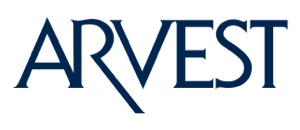
 Written by
Written by  Edited by
Edited by 
